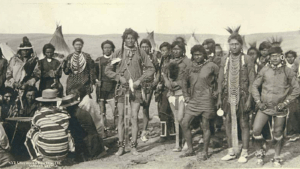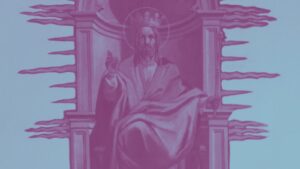Reading carefully the genealogy of Matthew 1:1-17
When my son was in elementary school (over a decade ago), a note came home from his teacher asking for baby pictures. The teacher wanted to display the pictures and let the students guess which baby was who. We sent in the oldest picture we had of our son–one that was taken in the weeks after he came to live with us at the age of three. Needless to say, everyone in the class knew exactly whose “baby” picture that was.
Just last week a lovely gentleman who has recently started attending our church said that he’d love to see a picture of me when I was three. “I bet your granddaughter looks just like you did at that age,” he said, gesturing to the admittedly adorable child coloring at another table. “Actually,” I explained, “she doesn’t. There’s no biological relation.”
It’s not that adoption is stigmatized or shameful in our culture. It’s just that often people don’t expect it or account for it or understand it. People’s baseline assumption tends to be that children are the biological offspring of their two (opposite sex) parents. Adoptive parents, single parents, step-parents, non-binary parents, parents who are part of same-sex and inter-racial couples–we all find ourselves in situations where the school project or event doesn’t seem to include our particular family configuration; where generally well-meaning people make ignorant (if not unkind) comments and we have to determine how much information to give in response.
And this is why I have come to count the genealogyGenealogy involves the study and tracing of families through the generations—in short, family history. One genealogy in Genesis traces the nations descended from Noah. In the New Testament Matthew traces the ancestry of Jesus back to Abraham, while Jesus' genealogy in the Gospel of Luke... More in Matthew–something I long considered just a tedious list of names–as one of my favorite passages of scripture.
I was originally drawn to MatthewA tax collector who became one of Jesus' 12 disciples. More 1:1-17 for the reason any good feminist preacher is drawn to it: the four fabulous women who are included in Jesus’ genealogy! Tamar, RahabWoman who sheltered Joshua's men when they came to spy on Jericho. More, RuthThe great-grandmother of David. More, BathshebaWife of David and mother of Solomon. More, and Mary are listed there along with all the guys, and I wanted to look more deeply into their lives and figure out how they fit into this JesusJesus is the Messiah whose life, death, and resurrection are God's saving act for humanity. More story that the author of Matthew is trying to tell. I had an amazing opportunity to write an Advent devotional that explores the stories of these women: Expecting Emmanuel. In writing this book, I did find rich meaning in the lives of these four women; and, unexpectedly, I also came to love the genealogy itself. In this list of difficult names, I discovered a messy, expansive understanding of family that I deeply appreciate.
The genealogy of Matthew traces the family lineage of “Joseph, the husband of Mary, of whom Jesus was born” (verse 16). We might think of Joseph as Jesus’ adoptive father, his step-father, his earthly father–but what Joseph is most definitely not–according to the Gospel accounts–is Jesus’ biological father. And yet it is through Joseph that the author of Matthew traces this all-important family history connecting Jesus to King DavidSecond king of Israel, David united the northern and southern kingdoms. More and AbrahamGod promised that Abraham would become the father of a great nation, receive a land, and bring blessing to all nations. More. Jesus’ relationship with Joseph is honored here as a true family relationship even though Joseph is not Jesus’ “real” father according to conventional norms.
In the stories of the women listed, we also see glimpses of non-traditional and messy family structures that are named and honored here in this recitation of Jesus’ ancestors. Tamar is not married to the father of Perez. Rahab is (was?) a sex worker and apparently of a different nationality than her husband. And Ruth (also in a mixed-nationality marriage) is a widowA widow is a woman whose spouse has died, often plunging her into poverty and putting her in a vulnerable position in society. Jesus, in his concern for the poor, regards widows with compassion and concern. More who marries a significantly older man and whose householdA household is a living unit comprised of all the persons who live in one house. A household would embrace all the members of a family, including servants and slaves. In the book of Acts, stories are told of various persons and their households, like... More seems to also include her ex-mother-in-law.
Then we get to what has become my favorite line in this chapter: “And David was the father of SolomonThird king of Israel who was known for wisdom and building the first Temple. More by the wife of UriahOne of King David's military heroes and the husband of Bathsheba. More” (verse 6). I probably read past this line a dozen times–and published a book on the genealogy–before I realized the weight of these few words in the first chapter of Matthew. Isn’t it curious that the author doesn’t label Bathsheba as the widow of Uriah, but the wife? Because according to the biblical text, Uriah was dead (by David’s command) and Bathsheba was married to David when she became pregnant with Solomon (2 SamuelThe judge who anointed the first two kings of Israel. More 12:24). Why not just say “David was the father of Solomon by Bathsheba”?
The ultimate effect of this completely unnecessary reference to Uriah is to remind readers of the violence David enacted against Bathsheba and Uriah–which is an odd thing to remind us of at the beginning of Jesus’ story. From a narrative and theological perspective, the purpose of including the genealogy here is to show that Jesus is in the line of King David so that we will believe that Jesus is, indeed, the MessiahThe Messiah was the one who, it was believed, would come to free the people of Israel from bondage and exile. In Jewish thought the Messiah is the anticipated one who will come, as prophesied by Isaiah. In Christian thought Jesus of Nazareth is identified... More. So why highlight (one of) David’s moral failings in the midst of this potentially straight-forward list of names?
Maybe because the Gospel writer wanted to tell the truth: like the IncarnationIncarnation literally means "embodied in flesh." It is a Christian doctrine, based on the witness in John's Gospel, that God's Word was made flesh in the person of Jesus Christ. The Apostles' and Nicene Creeds confess the central importance of the incarnation of Jesus. More itself, families are messy. Parents become parents–and live out their identities as parents–in so many different ways. Children are conceived and raised in a variety of circumstances–many of which do not fit the idealized concept of a “normal” family. And this is what God chooses to enter into–a human family in the fullness of its struggles and its love.
Whatever challenges I face–with my family and with those who may not quite understand my family–the genealogy reminds me that Jesus was also part of a complicated family system; that the complexity and messiness of family can also be part of its beauty; that family takes many forms; and that I am not alone in my struggles to live with and love well those connected to me by blood and other bonds.




